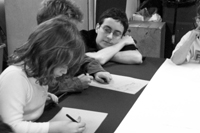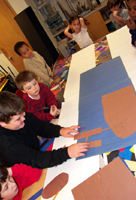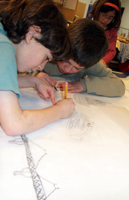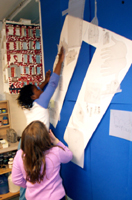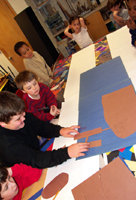The drawings that this group did after their conversation, while still revealing the children's emotions and sensitivities, offered more concrete ways of acknowledging and easing those needs. The children had designed playful spaces, nurturing spaces, joyful, bold, reflective, sad, relaxing, and hopeful spaces. All of the spaces that the children imagined were intended to address the varied and sometimes conflicting needs of children dealing with loss and all were to be brought together into one park created by the group.
Documentation Examples > Examples of documentation that is shared more widely
For Children, By Children: The World Trade Center Memorial Park
School: Corlears School, Chelsea, New York City
5. The Evolution
After these initial conversations, the children decided that the two groups would work collaboratively to create a design for one memorial park that combined everyone's ideas. They chose to make their park it's own island in the Hudson River near Ground Zero. That way, they would not have to worry about meeting with neighbors to get approval for their design. Two children had the idea to shape the island like the reflection of the towers on the river.
Ideas were negotiated on the basis of two unanimously decided criteria--the park was to make children happy and to make them feel safe. With this shared goal always in mind, Joachim had no problem surrendering his ideas about parachute jumps when his classmates pointed out that they would be too dangerous. The groups wove together and mapped their ideas before beginning to draw specific sites in the park individually or in small groups.
Over the next two months, while the children worked on their design, the walls of the school, particularly those between the classroom and studio, became more permeable. Discussions that began in the classroom continued in the studio. Amy and Barbara carved out time in the classroom for children to continue projects that had begun in the studio. Because the children wanted to preserve their studio time for actual drawing and building, the children's negotiations around ideas crept into other parts of the school day--lunchtime, block building time, and meeting times. The students met once a week in the studio and always arrived fueled with ideas and requests from their conversations and negotiations during the week.
The teachers offered the children every tool available to give them shared experiences within the design process. There were many visual explorations of scale and composition as the children used a Xerox machine and an old opaque projector to duplicate and enlarge the drawings on the wall and play with the placement and scale of the sites. The evidence of these explorations remained in the classroom during the weeks the children spent developing the design of their park. Maintaining the visibility of this design dialogue helped to support it by providing continuity and instant reference for the students each time they returned to the studio to work.
There was an energy that bordered on the chaotic in the studio. Children were exploring ideas and materials individually and in small groups, a way of working that offered opportunities for the children to evaluate and assess the park design in progress and to build knowledge for the future of the whole group collaboration. While one group worked on a miniature park model, they could simultaneously confer and negotiate with a group working on a map for the larger group design. All of this simultaneous activity in the studio provided an immediacy to the work that enabled adjustments to be made to the park layout within minutes of discoveries made elsewhere in the studio. The children tossed ideas and opinions out to the room, followed in rapid succession by appraisals and negotiated decisions.
Brigid: Standing back revealed to me such extraordinary skill on the part of the children to negotiate this compelling work. I marveled at the way the children choreographed their minds, bodies, and imaginations during the studio sessions. It was chaotic at times, but more often poetic.

